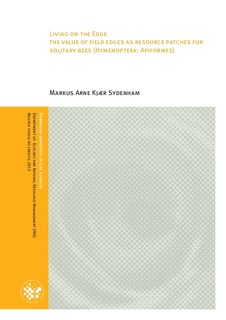| dc.contributor.author | Sydenham, Markus Arne Kjær | |
| dc.date.accessioned | 2012-09-14T11:34:25Z | |
| dc.date.available | 2012-09-14T11:34:25Z | |
| dc.date.copyright | 2012 | |
| dc.date.issued | 2012-09-14 | |
| dc.identifier.uri | http://hdl.handle.net/11250/186835 | |
| dc.description.abstract | Current patterns of anthropogenic land-use are reducing the diversity of pollinators through habitat destruction, degradation and landscape simplification. This may adversely affect both wild and domesticated flowering plants through pollen limitation. These concerns are supported in the parallel declines in solitary bees and wild plants
observed in Europe. Solitary bees vary in their requirements to nesting, mating and forage sites. In addition, bee assemblages fluctuate over years. Successful management of remnant habitat
patches therefore requires both the consideration of autecological traits and temporal patterns in bee diversity. In this study I sampled bees to evaluate the potential value of field edges in the
Norwegian agricultural matrix. I found that bee species were not randomly distributed in
the landscape. Furthermore, the solitary bee assemblages were relatively stable between
years but could be grouped by monthly affiliations. I isolated two groups of bee assemblages, one consisting of spring active bees and one of summer active bees. Furthermore I found group-specific responses to habitat conditions. The species richness and abundance of the spring-active group was negatively related to the proportion of agricultural land around the field edge, whereas the summer-active group preferred sunexposed field edges with short vegetation and a high floral richness. The group-specific responses reflect seasonal changes in the predominant bee species phenology. The spring group was mainly composed of Andrena species which burrow
nests in the ground and find forage in spring blossoming trees such as Salix caprea
Linnaeus. which are common in non-agricultural landscape types. In contrast, the summer group was more diverse in phenology and occurred at a time when the floral resources were more diverse.
These results suggest that field edges can provide an important asset in the conservation of solitary bees. The success of such management does however call for more research on the temporal variation in the autecology of bees. | no_NO |
| dc.language.iso | eng | no_NO |
| dc.publisher | Norwegian University of Life Sciences, Ås | |
| dc.subject | Zoology | no_NO |
| dc.subject | Entomology | no_NO |
| dc.title | Living on the edge the value of field edges as resource patches for solitary bees (Hymenoptera: Apiformes) | no_NO |
| dc.type | Master thesis | no_NO |
| dc.subject.nsi | VDP::Mathematics and natural science: 400::Zoology and botany: 480::Ecology: 488 | no_NO |
| dc.source.pagenumber | 55 | no_NO |
